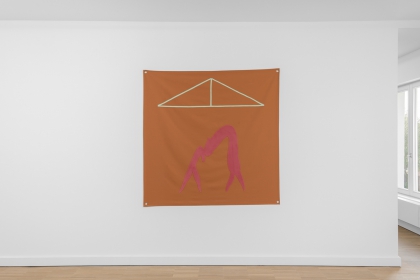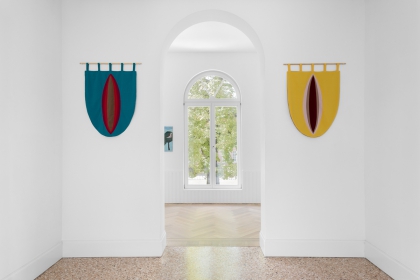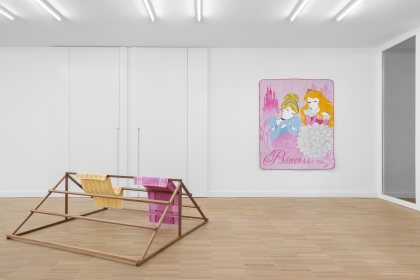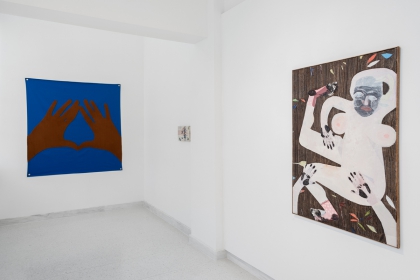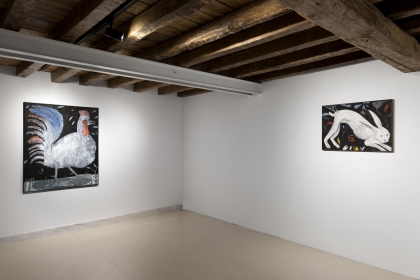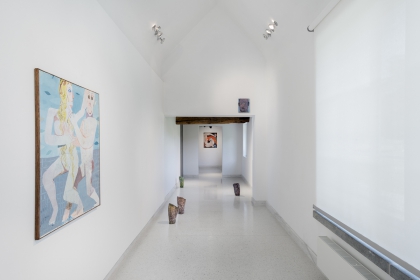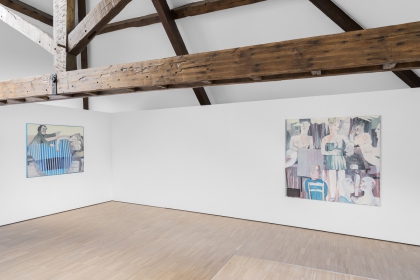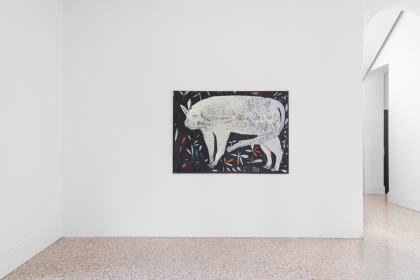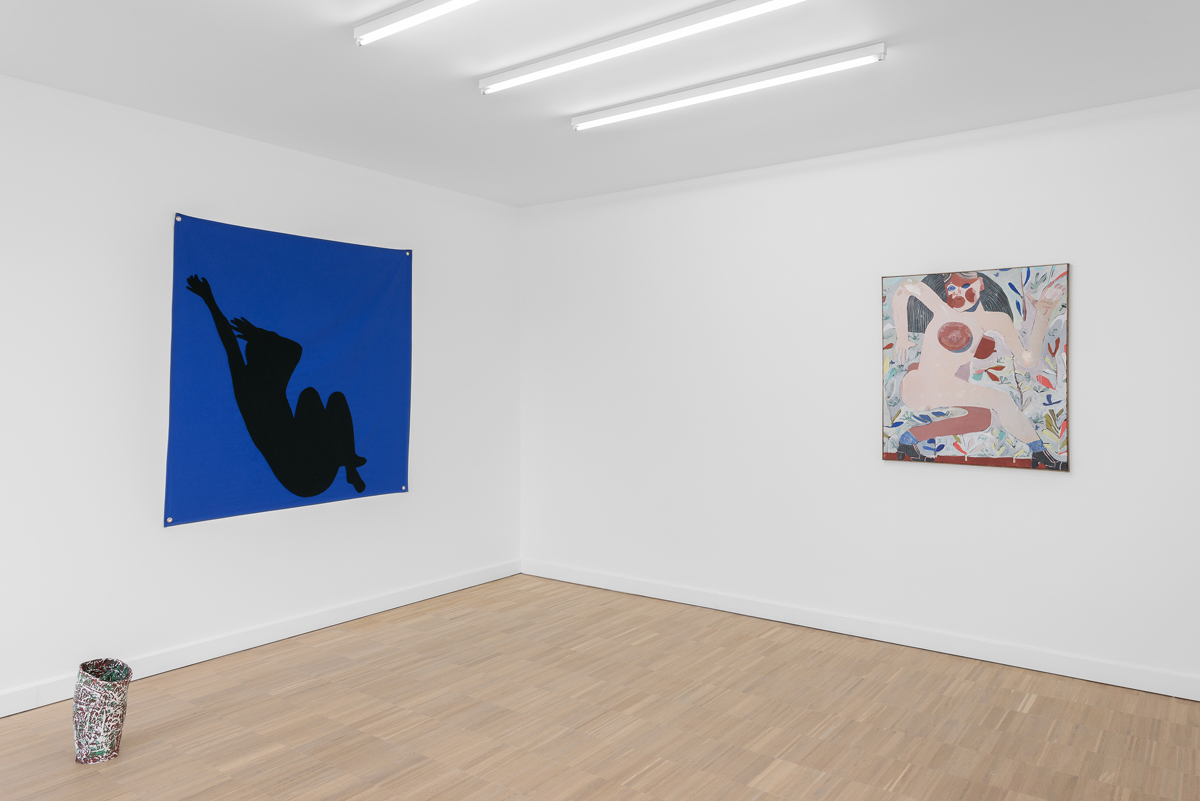
About hands, towels and nocturnal birds
Delphine Deguislage and Pieter Jennes were brought together by gallery owners Elly and Bert of The White House Gallery. They immediately saw interesting connections between what appear, at first glance, to be different approaches and visual languages. But did they also recognise the possibility that the interaction within I eat her lips and she eats mine would deliver the necessary dark humour?
Anyone who hasn’t met her yet, should certainly step into the encounter that her entire work aims to achieve. Delphine Deguislage has been piecing together her personal path for some time. As Fabienne Audéoud writes in the catalogue Fight, Fore, Free, To, One, her installations interpret ‘the physicality of materials, objects and bodies that interact with the specific place that they occupy’. The organic fusions and connections that she effects, often using household materials or substances from industrial contexts, inspire new compositions and dialogues. She appropriates her materials from other contexts. From beginning to end, the movement is never innocent. Moreover, it lives off the dust and sweat of others, as if it wants to gauge unearned and non-self-selected dependencies. Casts of fragments and her own body parts end up in a new tin of stories. The many displays of this are reminiscent of countless things at once: violence, punk, trash, family histories, a generation of women in the making, etc. Delphine reminds us, in particular, that many products are still handmade, just like her own work. Again those hands, which seem to work as a type of leitmotif in this exhibition.
Within this exhibition, Mothers (2018) is certainly an eye-opener, and also as far as Deguislage’s own work is concerned. It almost serves as a negligée, a less than obvious piece in the whole that, at the same time, allows an exceptional glimpse of something else. We would walk past it in a shop, because we know its purpose. It is a blanket that we understand will appeal to girls: pink, sweet, and ‘fit for a princess’ in terms of softness. There is something in the scrutiny of the eyes, of our eyes too, that captivates. In reality we are looking at a collage of the eyes from a photographic past: Delphine took the eyes of her mother and grandmother from a family photo in which she herself appears. She omits her own eyes, therefore. But this makes her way of seeing in Mothers even more visible. It results in a strange peepshow, in which we, the viewers, are watched by her mothers.
The two works entitled Sisterhood (# 1 and # 2, 2018), suspended high in the gallery space, are even more of a collage than Mothers. Or rather: they are collages, but subtler. They reference family heraldry – every clan can create a symbol of its past in the form of a shield or similar device. Deguislage’s works are in the image of medieval shields. Located on either side of the doorway here in the White House Gallery, they are almost re-enactments of that static, stately past. Of course, until we look again at the openings – and a certain stigma looms up. Of course, there is not a hint of doom to be found. These works are lighter than a shield and the materials have an almost ridiculous ‘colouredness’. They are far removed from the in-your-face seriousness of ‘l’origine du monde’. And more: we’re outdone by not one, but two vaginas. The shields could have been those belonging to the two bodyguards in Monty Python’s The Holy Grail but, in this case, a contemporary sisterhood version.
The mechanisms of contemporary oppression might not be the same as in Louise Bourgeois’ day, but the combination of autobiography, aberrant appropriation, distorted beings and body parts, found objects, treacherous domestic contexts and other cells, all so typical of her work, remain a unique source of inspiration. In Protect me from what I want (2018), Delphine tries to emerge from under an imposed ‘roof’ of longings that need to be satisfied. When she drapes her own grandmother’s towel over it with ‘What did you pass on to me’, suddenly, together with the work Mothers (2018), it not only reminds us of what ‘mothers’ have passed on. All of the ‘relics’ that she seemingly carelessly disperses in the exhibition spaces reinforce the discord that she finds so hard to shake off: how do I absorb as much space as possible (with my body) without becoming a remnant of a deserted past?
While we expect Delphine to give the gender orders, Pieter Jennes is an artist who searches directly for the misunderstandings and misconceptions between the sexes. The fun of playing radiates from his canvases. This is a painter who loves to slacken the reins. His figures are created once everything else has been filled up. The infectious happiness of working with paint hangs in the air. Taking a little more distance from the work might lead you to surmise that the innocent Bird watching (2018) is symbolic of his own observational drive.
Pieter taps into a fascinating transhistorical bias that is currently also being advanced by progressive museums and even pop icons such as Beyoncé and Jay-Z (video clip of ‘Apes ** t’). He demonstrates the desire to combine art-historical references and contemporary images and to allow them to collide with each other.
The artist is fascinated by the fauvism of André Derain, the expressionism of Gustaaf De Smet, the books of Kerouac (most notably, Maggie Cassidy) and the ‘model figure’ of Kiki de Montparnasse. These references interfere in multiple ways with the (art) history of his paintings. His retrospective look at the female nude, in particular, is not entirely out of the blue. It is striking to note that the gaze is never voyeuristic. And that is not a coincidence. In his view, during the 1930s, there was an interesting nudist counter movement in art – something that he gleaned from the art historian Carol Duncan – that renounced the voyeurism to be found in the work of artists such as Dégas, to cite a key example. The image of women and nature changed completely. It allowed for the rise of a liberated body that learned to look back at itself with pride. Pieter shows exactly the same obsession, at once both cautious and image-intensive. The artist himself describes it as an attempt to ‘not be an illustrator of my own stories’. An intriguing game of naïve appropriation and art-historical pastiche allows one to follow the movements of women and all kinds of semi-static animals with compassion. We expect nothing more from a man who paints naked women – that’s how people used to think. And today? He can’t only have meant it as a naked woman, can he?! And the mask that she wears (Cherry tree blossoms, 2018), isn’t that too much in favour of the ‘wild beasts’ of the fauvists? It is also no coincidence that there seem to be parallels between women and birds, as measured by the equal number of times they are individually portrayed by the artist. Emotions such as jealousy and ineptitude are placed in the titles of the works; they are ‘depicted’ in the image itself. When looking at Pieters’ work, certain ‘suspicions’ about the masculine gaze seem, to my mind, as tangible as the paint on the canvas. I see proof of this in the way that he deliberately chooses not to obscure the underlayers of his paintings. If you look closely, you can see them exposed around the lower edges (I did not love the girl she was jealous of, 2018). But if I take the opportunity to extend this trajectory a little further, are these suspicions then about his work, or about what is currently happening beyond it – in the public space?
Tom Viaene (Anderlecht, 1 September 2018)

